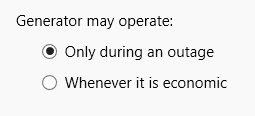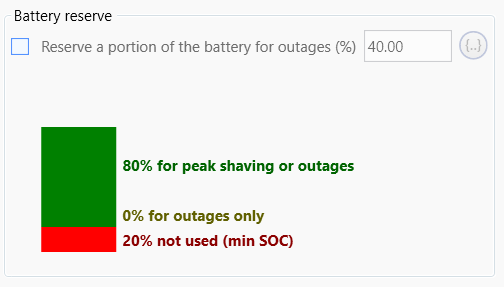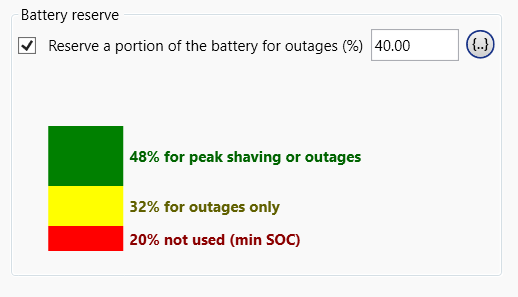
HOMER Grid 1.10

These settings apply to any outage in the system. The outages can be a Reliability outage and/or a Resiliency outage. Below are the inputs in Outage Settings:
•Operating Reserve Requirements during outage
Constraints
The Constraints section under the Outages allows you to modify system constraints, which are conditions that need to be met during an outage. HOMER discards systems that do not satisfy the specified constraints, so they do not appear in the optimization results or sensitivity results.
Variable |
Description |
Maximum annual capacity shortage |
The maximum allowable value of the capacity shortage fraction, which is the total capacity shortage divided by the total annual electric load, in % |
Maximum hours with capacity shortage |
The maximum number of hours in a year the system can have a capacity shortage |

Note: If you set "Maximum annual capacity shortage" to a non-zero value, then you have to set a non-zero value in "Maximum hours with capacity shortage". The minimum of the two inputs would be considered as the allowable capacity shortage during an outage.
Penalties
The Penalties section under the Outages allows you to define cost penalties that the system incurs during a capacity shortage.
Variable |
Description |
Capacity shortage energy penalty ($/kWh) |
A penalty for every kWh of capacity shortage |
Capacity shortage time penalty ($/hr) |
A penalty for every hour that there is a capacity shortage |

Operating Reserve Requirements during Outages
Operating reserve is surplus operating capacity that ensures reliable electricity supply even if the load suddenly increases or renewable power output suddenly decreases. HOMER defines the required amount of operating reserve using four inputs - two related to the variability of the electric load and two related to the variability of the renewable power. These four inputs are described in the required operating reserve section of the help. The total required operating reserve is the sum of the four values resulting from these four inputs. In its simulation, HOMER operates the power system so as to keep the operating reserve equal to or greater than the required operating reserve during an outage. It records any shortfall as a capacity shortage.
Variable |
Description |
As a percentage of load: |
HOMER adds this percentage of the primary load in the current time step (AC and DC separately) to the required operating reserve in each time step. A value of 10% means that the system must keep enough spare capacity operating to serve a sudden 10% increase in the load. |
As a percentage of load: |
HOMER adds this percentage of the peak primary load (AC and DC separately) to the required operating reserve in each time step. It, therefore, defines a constant amount of operating reserve. For example, if the peak AC primary load is 40 kW and you want to ensure at least 8 kW of operating reserve on the AC bus at all times (maybe to cover an 8 kW motor starting load), set this input to 20%. |
As a percentage renewable output: |
HOMER adds this percentage of the PV array power output to the required operating reserve in each time step. A value of 25% means that the system must keep enough spare capacity operating to serve the load even if the PV array output suddenly decreases 25%. |
As a percentage renewable output: |
HOMER adds this percentage of the wind turbine power output to the required operating reserve in each time step. A value of 60% means that the system must keep enough spare capacity operating to serve the load even if the wind turbine output suddenly decreases 60%. The more variable you expect the output of the wind turbine to be, the higher you set this input. |
Note: To the right of each numerical input is a sensitivity button ( ) that allows you to do a sensitivity analysis on that variable. For more information, see Why Would I Do a Sensitivity Analysis?
) that allows you to do a sensitivity analysis on that variable. For more information, see Why Would I Do a Sensitivity Analysis?

Generator May Operate
Select “Only during an outage” if you want the Generator to operate only during the outage.
Select “Whenever it is economic” if you want allow HOMER to optimize the usage of the generator. This option will allow the generator to operate during non-outage events as well.

Battery Reserve
The option to "Reserve a portion of the battery for outages" in the Outage Settings menu restricts how much of the battery can be used of peak shaving. When HOMER Grid chooses the demand limits for each month, it will make sure that the battery state of charge never goes below the reserve level you set. If an outage occurs, HOMER will use all the energy in the battery to serve the load during the outage. This includes the portion reserved for outages, but does not include the portion below the battery minimum state of charge.
This option can't be set when you have selected the option "Dispatch algorithm has advance knowledge of these outages" in the Resilience menu and/or the Reliability menu.
You can ensure that when the outage occurs, your battery has certain % of capacity left to serve some of the critical load. You can use this option to specify what (minimum) percentage of the battery you want to reserve for outages. The red section is the minimum SOC, which is defined on the battery inputs page.

The percentage of reserve for the outage is the percentage of the remaining capacity, which should be reserved for the outage. So, if the battery’s minimum state of charge is 20%, and 40% of the remaining capacity for an outage, this will result in 32% of the battery’s total state of charge being reserved for the outage because 40% of the available 80% is 32%.

